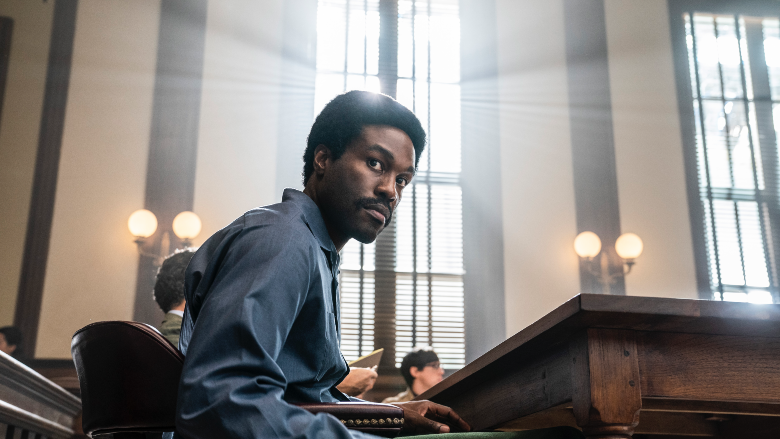
Cinematographer Phedon Papamichael, ASC, may not be a household name, but there’s a strong chance that you’re familiar with his work. Papamichael has frequently worked with James Mangold, most recently on 2019’s Ford v Ferrari, and he earned an Oscar nomination for his work on Alexander Payne’s Nebraska. In addition to collaborating with Mangold and Payne, Papamichael has also worked with George Clooney on a few films.
The Trial of the Chicago 7 marks his first collaboration with Aaron Sorkin, and during a conversation lasting almost 40 minutes, Papamichael discussed working with Sorkin on the film. Besides discussing the challenges of working on a period piece and recreating the 1968 Chicago riot, he also goes into the specifics of lighting the courtroom scenes and the decision-making that went into utilizing three cameras.
Before this late October interview, Papamichael had wrapped principal photography on shooting his fifth feature film as a director, Light Falls. He tells Below the Line how that film was able to shoot during the pandemic, sharing insights that may be useful for other production shoots.
Below the Line: The Trial of the Chicago 7 is a masterpiece, and my #1 film of the year. It also marks your first time working on an Aaron Sorkin project. What was it that attracted you to the film?
Phedon Papamichael: Aaron Sorkin is as we all know an exceptional talent and writer. I had read Molly’s Game. It’s sometimes hard for me to read scripts that are close to 200 pages, but I just blew through that. It was like a page turner. I loved how he deep fragments things and goes nonlinear and overlaps. The timeline is taking you to all kinds of places and it really makes things move. When Stewart Besser—a producer who I had worked with before on Identity and 3:10 to Yuma—approached me about Aaron doing Chicago 7, I was excited to meet him.
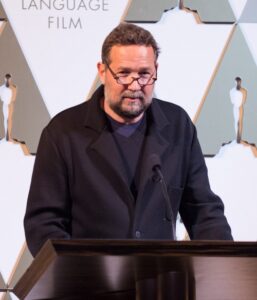
It was the end of the year. I was still in post-production on Ford v Ferrari. I didn’t really expect to make a movie that fall. But this one — being in New York and in Chicago, and the subject matter — I was very enthusiastic about meeting him. We had a meeting, and it was very brief. He literally went, “I’m happy you’re interested in doing my film. I’m gonna rely very heavily on you for the visuals.” That’s about it. That was our initial interview, and then, he excused himself. I said to Stuart, “Hold on, how does this really work?” And he was like, “Well, he’s a man of the word, the written word, the rhythm of the language, but how to translate it onto a screen would really fall a lot into your lap, which, I’m fine with going into it.” My previous experiences, of course, with Mangold — he’s very involved visually with all the details, with setting up shots, deciding how the blocking will play out, and how the little finesses in the camera moves affect the storytelling.
Aaron said, “I really want to use long lenses.” I was like, “Well, I think it’s very important that we maintain some connectivity between the characters because it’s not just about the person who’s making a statement or saying something. It’s about seeing reactions, hearing the defendants when one of them speaks. They’re not always on the same page.” I suggested doing something that I’ve developed with Mangold, which is covering—although you have an intimate close-up but being physically close with the camera, and then on a wider lens, although you have an intimate close-up, it still doesn’t isolate them. It includes other players, you can do little slider moves, little rotations, that are not a statement that are hard to perceive sometimes but they do always emphasize a certain emotion like a little push-in or little shift that includes the person sitting next to them.
I did a lot of those things. Basically, it came down to Aaron bringing in the cast and reading through the scenes that we were going to do that day, and then him leaving all the coverage up to me, which was, good and challenging. I also wanted to make sure I’m not hitchhiking the film away from him and not giving him things he really doesn’t need and understanding the rhythm of the language, the pace of the screenplay, and not designing shots that would hinder or get in the way of that. I think that was the ultimate challenge—telling what’s important to him in shot that don’t prevent the editor from establishing that pace in that interaction that exists in the screenplay in the writing.
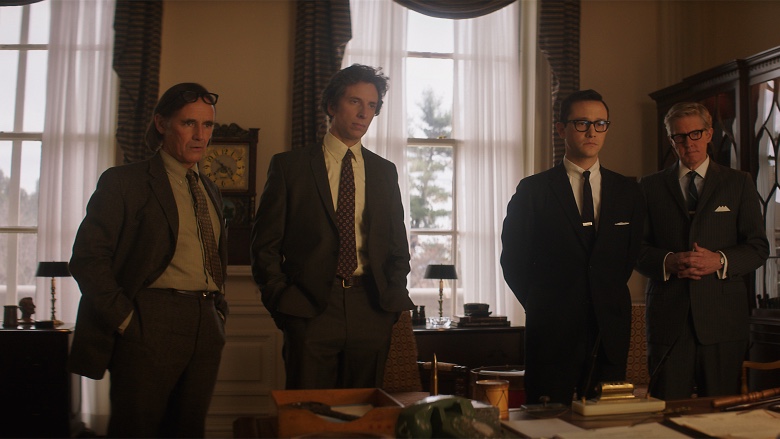
Overall, a very challenging, but also intriguing task. About 60% of the screenplay, I would say, is in the courtroom, and then having all these vignettes and leaving the courtroom and as various witness reports or stories unfold, you’re constantly coming in and out of the courtroom. The courtroom took place over a very long period of time—from September till February. I also established lighting scheme and really wanted to create different moods for whenever we’re coming in and out of the courtroom so it doesn’t become visually boring.
I assigned a lighting pattern to each court day that exists. I made this little spreadsheet, and we’re actually in the courtroom on 14 different days in the screenplay. I was going through it and looking at the mood of each scene. I decided this one should be sunny like day one, the opening of the trial, because there’s still a bit of enthusiasm and sort of the whole world was watching in a positive revolutionary energy going into it. Then of course, a lot of things turn sour during it and so for some scenes, I thought this would be more appropriate in the moodier winter’s day. September 24 is trial day one and February 18 is the last day with the verdict. I had a lot of timeline to play with. I just kind of went through it and instinctively and emotionally pick what scenes should be in the moody rainy day or in a sunny day. Also, understanding a rhythm of going back and forth between the vignettes or cutting out to the riots or cutting out to the conspiracy office and try to find a balance that that takes away the monotony of having to cover a fairly static courtroom procedure and mix it up with different tonalities.
Like the last day again, I went sunny. When the verdict is read, and Tom Hayden stands up and makes this final statement but starts reading out all the names of the fallen and he’s wearing his white prison outfit, I went a little more aggressive with the sun and the light on him and sort of having glow like this heroic angelic figure. When Abbie Hoffman is on the stand, it’s a bit more somber moment where he realizes and he actually makes a statement, “Give me a moment, I’ve never been on trial for my thoughts before.” It was establishing that kind of visual timeline and tracking that throughout was very hard to shoot because we didn’t have a lot of extras that were budgetary restraints. At the block shoot a lot of scenes—some scenes are only one line, hree lines, other scenes are 16 pages. We have to shoot certain directions often and complete four scenes, avoiding the audience in the courtroom and then come back the next day and finish the four scenes when we actually had extras to fill the courtroom or partially filled the courtroom. It was kind of a logistical nightmare and I got through it by really collaborating with Script Supervisor Shane Scott tracking all that. I would dictate our shot list every day and make sure I didn’t miss any beats.
Aaron would come and we’d do the takes. Often, he’d be like, “We’re done, right?” I’m like, “No, we still need to get the jury and we still need to get the reaction of the judge.” To him, it’s really so much about the rhythm of the word and less about being involved in thevisuals. He’s the first one who admits it. He says, “I am really gonna rely heavily on you.” It’s also my job to offer him certain things but not really take it in a different direction—offer him options and cutaways and also talking with the editor Alan Baumgarten about really needing these shots. That was sort of more involvement on my end than with my usual collaborations. That’s how it was working with Aaron Sorkin.
BTL: What was it like to work with Aaron Sorkin?
Papamichael: It’s really interesting, because he had very specific things that he needed to capture visually, which are things that trigger moments in the screenplay. For example, like throwing a bottle and what started the riots and I need this insert of a bottle hitting the ground I’m like, “Yeah, we’ll get the insert of a bottle hitting the ground but right now, we have 200 extras trying to cross the bridges and lining up all the National Guard with the daily dozers,” but he had very specific of things that were key visual elements for him. Those were the ones that he actually requested but you still have to construct all that stuff around it. But you also have to understand that often, the whole sequence of taking the bridges, crossing, and trying to get to the Democratic National Convention—that story is told in 5-15 second sequences that you leave the courtroom for. We wanted to also really switch up energy when we left the courtroom because the courtroom is more classically composed and not a lot of camera move. When I left it, I wanted to introduce a lot of energy and would send my two camera operators handheld to immerse in the crowd. I would tell them to just kind of go out and make a documentary about that. And also, it helped us mask the fact that we didn’t have that many extras. But just putting them in the crowd and really catching that vibe of Haskell Wexler, his Medium Cool was just out there basically integrating his doc footage with his narrative that he created for Medium Cool. We also discovered a lot of available stock footage of documentations from that time—in addition to Haskell’s footage. I think even the Chicago Police has stock footage from then. Alan was very smart and elegant about integrating that with our footage. We created some authenticity and some energy with that.
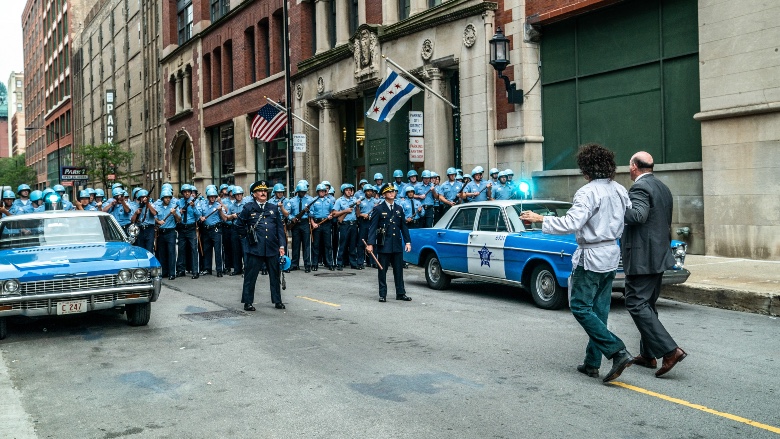
BTL: The film shot in Chicago last year. Were there any challenges that came with recreating the late 1960s?
Papamichael: Well, luckily, we had the great advantage of being able to shoot in Grant Park. When they say, “Let’s take the hill,” we’re actually looking at the hill with the statue on top. Also, luckily, a lot of architecture off of Michigan Avenue in Chicago hadn’t really changed that much. There were a lot of authentic landmarks. Even the bridges—with the lanes painted on the bridge—were still the same. There’s some modern architecture we had to avoid. We had very little money for the effects. This was a low budget film. It was a 35-day shoot, probably just around $20 million. It is a period movie that’s recreating a fairly large historical event. At the actual event, there were over 10,000 people present and we have to sort of recreate that atmosphere with maybe 200 people on our best days—sometimes a hundred; sometimes 80. We have to be very smart about how we cover and how we shoot it. How we maneuver through the day. Everybody had to go through hair and wardrobe—a lot of extras.
The courtroom was actually built in abandoned old church that was in Paterson, New Jersey. The extras were coming mostly from New York so it was just very hard to get everybody ready and the availability of when we had them was very limited. That was the challenge. Being smart about how you shoot it, what you can see, how you can block it. And again, we were a bit late. The actual event was in the summer and it was sunny. We were almost in the fall. We had some big weather issues.
BTL: How cooperative was the weather in Chicago when it came to filming outdoors?
Papamichael: It could have been worse, but we definitely had the trees changing color, which we could address some of that in the DI. Skip Kimball, my colorist, was able to take some of the yellow out and it was overcast. We were also using Haskell’s footage. It’s pretty high con 16mm star Kodak probably and sunny so just not really being able to light and control that but still creating some contrast and making it feel like summer. All the extras are dressed for summer and it actually kind of got quite cold at night. We got away with it. It was maybe four days in the park. Altogether, I think we were one week in Chicago.
The courtroom—I designed the lighting knowing that I’d have short daylight hours. The court typically took place from 10 AM to 4 PM so it’s all-day interiors. I knew my shooting days would be longer so I created a big box of light outside the two big windows. I was able to control and switch over the moods from indirect, softer, moody light to sunny light. I knew within one day I would have to change over the lighting situation several times. I treated it almost like a stage by creating this box that sealed in the windows and enabled me to switch over the lighting very quickly with Bill O’Leary, who’s a very experienced veteran Gaffer based in New York. He has done most of Roger Deakins’s movies, including doing The Irishman last year. I had a very experienced, great crew, and Tom Prate, the key grip—dealt with our limitations as effectively as I could.
Aaron was also battling constantly to get the actual location and to get more extras. It was a relatively small movie tackling a historical period film. I wanted to use multiple cameras in the courtroom, because again, I didn’t really want—some pages run very long. I knew we wouldn’t get through it by repeating it over and over again. I knew I had to assign cameras to different groups of the court. I’m normally not a fan of multiple cameras but in this case, I really insisted on having three bodies. I actually wanted four camera bodies but getting three cameras and three camera crews so we could maneuver through the coverage efficiently.
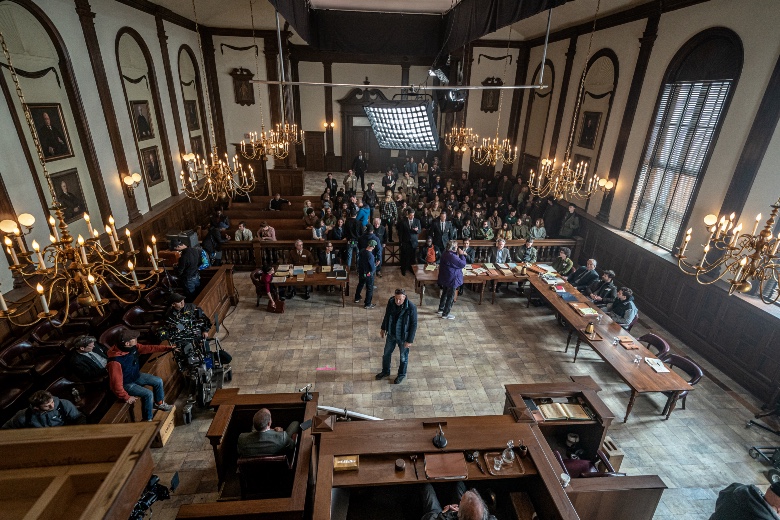
BTL: My next question was going to be about the three-camera approach in the courtroom.
Papamichael: I would have to simultaneously run something on the prosecutors. There are so many defendants—eight of them; at some point, seven—and the attorneys. I really needed everybody’s reaction, because even if one is doing something, it’s very important how the others react to it. I really needed to cover all of them somehow, in various sizes, for every scene. It would have just been too much repetition for the performance to have to move camera and redo everything every time.
BTL: What led to the decision to shoot the riot scenes as if it were a documentary?
Papamichael: Part of it out of necessity because I couldn’t really go a very wide cinematic scope. But also, just to maintain that energy, which was in contrast to the courtroom. It just felt like the way to do it and really get in there and do handheld and pick up that energy of the violence, the movement, and really have it less designed and more random. Of course, we were looking for a specific beat, but other than making sure you get them pulling the girl down with a flag. I mean, run through the crowd and find it rather than designing a specific shot. We always got a lot of extra little pieces and gifts just by letting my operators loose and telling them, “Just go, be instinctive, and think like a documentary filmmaker and just capture whatever you can along the way” to that specific beat that also needs to, of course, be captured but whatever else we can pick up. Everybody was on their toes and had an understanding of being very reactive and intuitive.
BTL: How much of an influence was Haskell Wexler’s Medium Cool in terms of the film’s look and did any other films inspire the look?
Papamichael: I looked at movies from that period, but not even really studying them so much. I did want to create some mood, but I didn’t want to push the period photographically so much. I usually let that come more from production design, wardrobe, and locations. It’s not like I want to create a ‘60s-‘70s visual that I enforce upon it like with certain tonality throughout. I let of that come from the production design and collaborating with Shane Valentino, who’s also open to interpreting that period—same with our costumes. There’s something about authenticity but there’s also something about creating a new story that’s timeless. And this story, unfortunately—sadly I should say—is still very relevant and timely, especially right now. Even considering that the script was written like 13 years ago, it couldn’t come out to a more relevant moment.
I did use the lensing that I used on Ford v Ferrari, which was expanded anamorphics, which I really like. The texture of those lenses, they’re not so optically perfect. They have a certain period feel because they’re older glass anamorphics that have certain flare characteristics and that in combination with a large format Alexa LF, which has a certain quality of fall-off and the depth of field that I do think you get a film look in that also in combination with adding film grain with Skip Kimball in the DI and not to an extreme degree but it does give it a different texture and emotional texture that that is not modern, I should say.
Medium Cool influenced the energy of the staging of how the extras were and to what degree the violence took place. Also, another important influence was the use of tear gas, which, of course, we recreated with atmospheric smoke and dialed it in based on the doc footage. That also helped us and help mask the fact that we were short on extras and also avoiding non-period structures. We did bathe everybody in a cloud of tear gas.
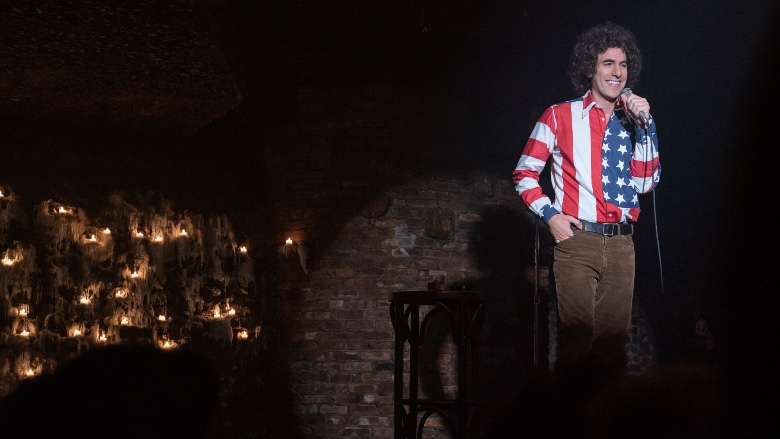
Was it a nice change of pace from working on Ford v Ferrari?
Phedon Papamichael: Very different. Ford v Ferrari—although it has action and moving cars, which is fun, Mangold is also always about the characters and creating strong characters and friendships. In the case of Ford v Ferrari, collaboration. This has similar themes. It’s about struggling to achieve a common goal and your ups and downs going through that process and tensions. I’m always attracted to character and strong storytelling.
I very much enjoyed it. Of course, I very much enjoyed Ford v Ferrari because that just brought a whole other set of challenges with high-speed vehicles and action sequences but the heart of that movie as well as is Christian Bale and Matt Damon’s relationship and same as Abbie Hoffman and Tom Hayden here. That’s always to me the most interesting—same on Nebraska. Sure, it’s amazing doing black and white out in the fields. The graphics and the visual compositions on Nebraska reflect the loneliness of the characters. The highlights are the little moments that Bruce Dern would bring with his relationship with his son (Will Forte). Little looks, little connections, and when to go to a close-up, not really—I always feel like a close-up is a strong moment — you can overuse it. I always like to stay wide, tell the story wide, and let the audience be able to observe and take in things and then really savior and keep the close-ups for very specific moments. It’s harder to do in a courtroom drama because everyone is sort of interacting and requires different kind of coverage. In a way, it’s more challenging to really tell it visually. You liked it so some people are really very much inspired by the story and by this particular film. I hope we found an audience and, again, sadly, I mean, it’s good for the filmmakers, I suppose, but it’s coming out in a very relevant moment for it.
You’ve been directing Light Falls this year. Can you speak to the challenges of filming during a pandemic?
Papamichael: I was fortunate enough to be able to get this film going. Light Falls is a thriller set on a Greek island, but because of the nature of the story, it takes place mostly in one building—an abandoned hotel with a fairly small cast. I was able to apply a lot of natural lighting and not really carry a large crew. It was actually ideal for our pandemic regulations. Of course, we took a lot of precautions. We wear masks. We were testing and checking temperature every morning. We were doing testing before the shoot started in pre-production, right before principal photography. Halfway through the picture and we got through it. We had nobody come down with any symptoms. We had no cases. Luckily for us, we managed to work pretty much with normal conditions we’re used to.
The stories I’m hearing back from the US are entering studio lots and everybody getting tested every morning. Also, of course, having much larger crews that you have to go through the process of everybody getting tested and additional time required and additional cost. I really didn’t feel that much on my project. It’s smaller independent film. There are shoots in Greece that came down with cases and had to shut down so I feel lucky that we were able to squeeze this out. Also, just as I wrapped, we’re having an increasing number of cases and experiencing what the world calls the second wave and we really don’t know what this winter window will bring and how work will continue.
Currently, I’m in Slovenia doing a fairly large commercial. Since I got here, they shut down all the restaurants. They just introduced curfew, starting today at 9 PM. We’re basically isolated in our hotel. Depending on what country you’re in, it can get very strict up to the point where it becomes prohibitive to attempt a production. In Greece, it’s still fairly workable and reasonable, but things change weekly and then the government is constantly adjusting, so you never really know what the next week will bring and what new regulations will come out, but it could prevent you from finishing a film. It’s tricky.
The Trial of the Chicago 7 is currently streaming on Netflix, and presumably, you’ll be able to see Papamichael’s Light Falls sometime in 2021.
All photos by Niko Tavernse, courtesy of Netflix, except where noted.





